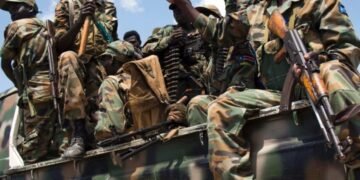Dubai in the middle of Al Aweer desert, stretched across a square kilometre, Dubai’s Central Prison is home to more than 4,000 convicts.
The prison operates like a small town. It has a medical centre, supermarket, education centre, craft workshop and the prison administration are working on plans to develop an internal radio and TV station, and hospital.
Major General Mohammed al Suwaidi, the head of the Punitive Establishments Department, said the priority was to keep the prison clean and healthy, and have rehabilitation programmes that prevented inmates from returning to a life of crime.
To keep the large number of convicts in check, strict measures are taken from the moment a prisoner arrives. An inmate’s first port of call is the registration section. He hands in his belongings and is issued an identity card that also serves as a debit card in the prison supermarket.
These cards can be topped up by family members or friends to a monthly average limit of Dh1,000.
Lieutenant Mohammed al Sayagh, head of the consignment section, said the flow of inmates arriving varies.
“Sometimes we have up to 40 people in one day, and other times about five,” he said.
Next, the prisoner receives his uniform: a white shirt and trousers with a colour-coded stripe around the chest indicating his sentencing. A red stripe indicates a sentence of more than seven years, yellow for three to seven years, blue for three years to six months and green for less than six months.
Finally, he undergoes a medical check-up and is placed in quarantine until the results of all blood tests are processed.
Once the registration process is complete, the prisoner is assigned to a cell. The prison is made up of four buildings: the male prisoners are housed in two buildings, female inmates are housed in another and juveniles are housed in the fourth.
Male convicts serving terms of more than a year are housed in one building, and convicts serving less than a year are housed in another.
Those serving terms for drug addiction are kept in seclusion from other prisoners.
“They are separated so they do not teach other inmates drug addictions,” Maj Gen al Suwaidi said.
Each prison building has four wings, and each wing houses 10 rooms of five square metres, each with four to six beds and a bathroom. There is also a recreation room in each wing, with a television and a telephone.
The inmates are assigned a daily activity, depending on which rehabilitation programme they have been assigned to undertake. The rehabilitation can be either vocational or give inmates the opportunity to further their education.
The prisoners also have breaks where they can spend some time on the exercise ground, borrow books from the library, participate in sports or watch television.
Prisoners who step out of line face disciplinary measures, including bans on phone calls, receiving visitors or shopping in the supermarket.
The period of the ban is decided depending on the severity of the violation. Any inmate who commits a serious offence in prison, such as getting into a fight, has a criminal case registered against him and can face additional sentencing.
Source: Agencies
















